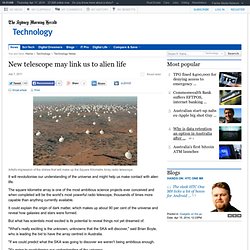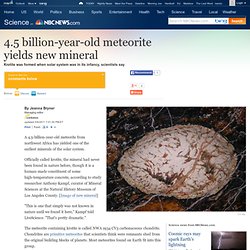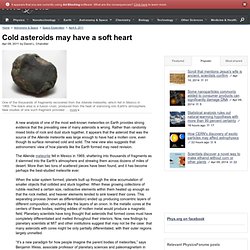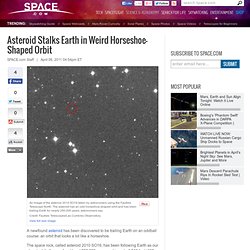

The Scale of the Universe 2. The Scale of the Universe. Massive meteorite found in China. A massive space rock – one that could rank as one of the largest meteorites ever recovered – has been found in a remote and mountainous region in northwest China, according to news reports.

The huge and oddly-shaped rock was found in the Altai mountains in China's Xinjiang Uygur province, according to Sky and Telescope magazine. Earlier this month, Baolin Zhang, a meteorite specialist at the Beijing Planetarium, led a small team up a 9,500-foot (2,900-meter) summit to investigate reports of the supposed meteorite. "This is a huge iron meteorite," Zhang said in footage from China Central Television. "It may be the second largest iron meteorite, which can cause a sensation in China and also attract attention from [the] world's meteorite fields. It comes from outside solar system and it is of great appreciating value and of more scientific value. " Russia launches 'bigger than Earth' radio telescope. The Spektr-R observatory, called RadioAstron, has spent 30 years on the drawing board – but experts hope that its huge range will compensate for the delays in getting it into space.

Square kilometre array. Artist's impression of the dishes that will make up the Square Kilometre Array radio telescope.

It will revolutionise our understanding of the universe and might help us make contact with alien life. The square kilometre array is one of the most ambitious science projects ever conceived and when completed will be the world's most powerful radio telescope, thousands of times more capable than anything currently available. It could explain the origin of dark matter, which makes up about 90 per cent of the universe and reveal how galaxies and stars were formed.
But what has scientists most excited is its potential to reveal things not yet dreamed of. Advertisement. 4.5 billion-year-old meteorite yields new mineral - Technology & science - Science - LiveScience. A 4.5-billion-year-old meteorite from northwest Africa has yielded one of the earliest minerals of the solar system.

Officially called krotite, the mineral had never been found in nature before, though it is a human-made constituent of some high-temperature concrete, according to study researcher Anthony Kampf, curator of Mineral Sciences at the Natural History Museum of Los Angeles County. [Image of new mineral] "This is one that simply was not known in nature until we found it here," Kampf told LiveScience.
"That's pretty dramatic. " The meteorite containing krotite is called NWA 1934 CV3 carbonaceous chondrite. The mineral, a compound of calcium, aluminum and oxygen, needs temperatures of 2,732 degrees Fahrenheit (1,500 degrees Celsius) to form, supporting the idea that it was created as the solar nebula condensed and the planets, including Earth, were formed, the researchers say. When meteors hit the ground they are called meteorites. Cold asteroids may have a soft heart. A new analysis of one of the most well-known meteorites on Earth provides strong evidence that the prevailing view of many asteroids is wrong.

Rather than randomly mixed blobs of rock and dust stuck together, it appears that the asteroid that was the source of the Allende meteorite was large enough to have had a molten core, even though its surface remained cold and solid. How a penniless mystic won Russia the space race. Asteroid Stalks Earth in Weird Horseshoe-Shaped Orbit.
A newfound asteroid has been discovered to be trailing Earth on an oddball course: an orbit that looks a lot like a horseshoe.

The space rock, called asteroid 2010 SO16, has been following Earth as our planet orbits the sun for at least 250,000 years and is up to 1,312 feet (400 meters) wide, scientists said. It was initially spotted by NASA's WISE infrared space observatory. [Photos of asteroid 2010 SO16 and its orbit] Space Science - Integral spots matter a millisecond from doom. Integral spots matter a millisecond from doom 24 March 2011 ESA’s Integral gamma-ray observatory has spotted extremely hot matter just a millisecond before it plunges into the oblivion of a black hole.

But is it really doomed? These unique observations suggest that some of the matter may be making a great escape. No one would want to be so close to a black hole. Ordinarily, it takes just a millisecond for the particles to cross this final distance but hope may be at hand for a small fraction of them. Thanks to the new Integral observations, astronomers now know that this chaotic region is threaded by magnetic fields. This is the first time that magnetic fields have been identified so close to a black hole. Integral's IBIS imager sees Cygnus X-1. Chinese want to capture an asteroid into Earth's orbit. While most astronomers seem to be understandably worried about the best way to steer asteroids away from Earth, Chinese scientists are instead trying to figure out how they can capture nearby asteroids into Earth orbit.

And then mine them. At first glance, nudging an asteroid closer to Earth seems like one of those "what could possibly go wrong" scenarios that we generally try and avoid, and for good reason: large asteroid impacts are bad times.